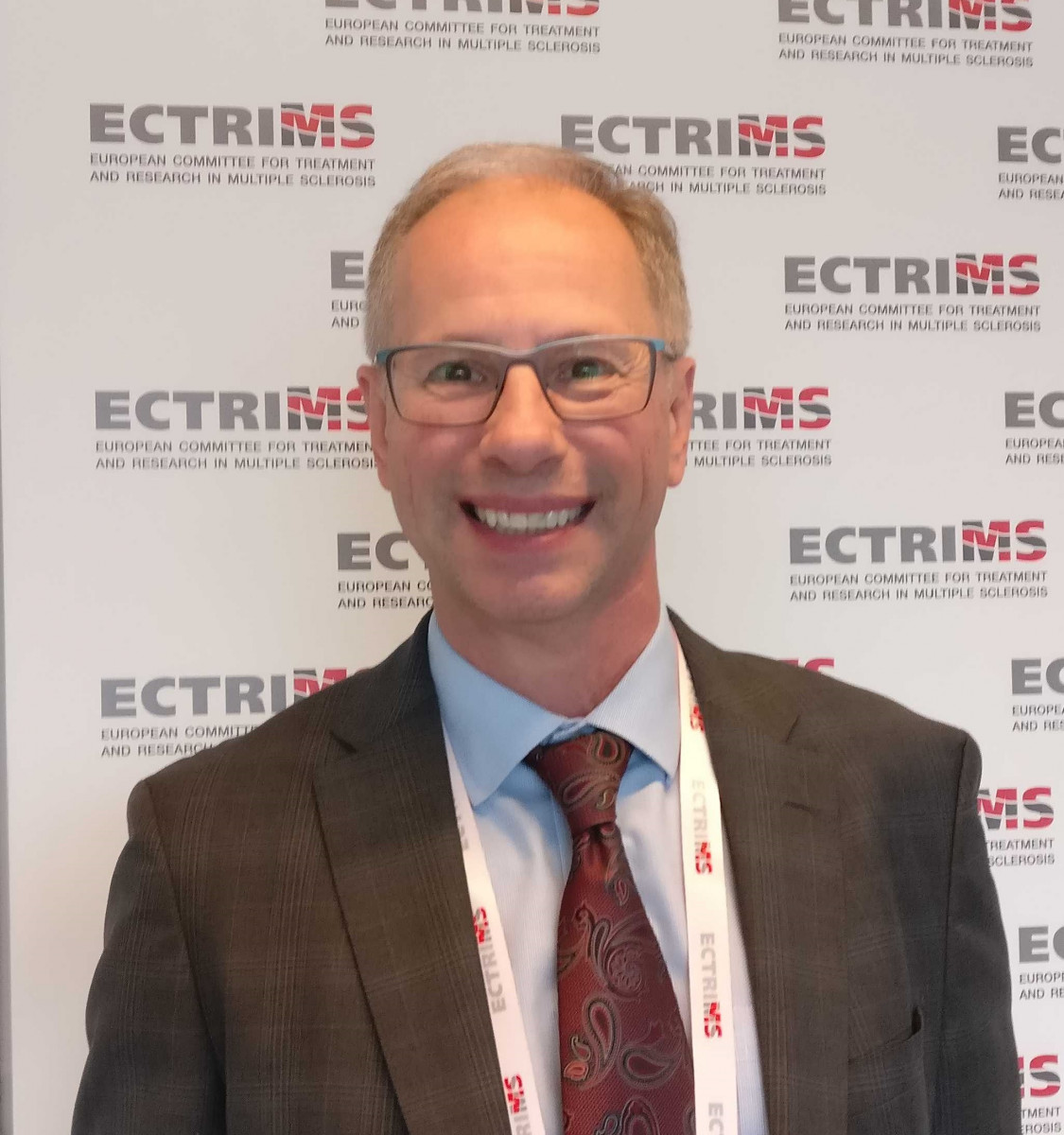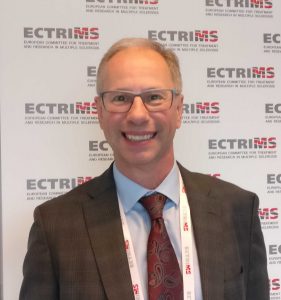#ECTRIMS2019 – Ozanimod’s ‘Key Advantages’ May Lead to New First-line MS Therapy: Interview with Neurologist Jeffrey Cohen
Written by |

Jeffrey Cohen,a neurologist with the Cleveland Clinic. (Photo by MS News Today.)
Celgene‘s oral ozanimod, if approved, could be a first-line oral treatment option for people with relapsing multiple sclerosis (MS), and one with relatively minor side effects.
Recent results from the Phase 3 trials RADIANCE (NCT02047734) and SUNBEAM (NCT02294058), published in the journal The Lancet Neurology, showed ozanimod — now under review for approval — to be significantly more effective than Biogen‘s Avonex (interferon beta-1a), an injectable and established first-line MS treatment.
Both studies found that people with relapsing forms of MS treated with ozanimod capsules (1.0 or 0.5 mg, given once daily) experienced a reduction in disability progression, fewer MS relapses, and a decrease in the number of active brain lesions compared to those treated with Avonex. Importantly, both doses of ozanimod were well-tolerated.
One of the leading researchers in these studies, Jeffrey Cohen, MD, a neurologist at Cleveland Clinic‘s Mellen Center for MS, shared his thoughts with Multiple Sclerosis News Today about ozanimod’s promise as a first-line therapy for relapsing MS. He spoke in an interview at the 35th Congress of the European Committee for Treatment and Research in Multiple Sclerosis (ECTRIMS), held Sept. 11–13 in Stockholm.
Ozanimod (formerly RPC1063) is an oral sphingosine-1 phosphate receptor (S1PR) modulator, belonging to the same class of compounds as Gilenya (fingolimod) and Mayzent (siponimod), two approved oral treatments by Novartis.
S1P receptors are a type of protein found on the surface of lymphocytes (immune cells such as T- and B-cells), which are required for lymphocytes to exit the lymph nodes and enter circulating blood.
Ozanimod selectively blocks the types 1 and 5 of these receptors, retaining lymphocytes in lymph nodes, and thus preventing them from reaching the brain and spinal cord. This is expected to lower the number of lymphocytes in the central nervous system, reducing inflammation and damage to nerve cells.
Gilenya was the first S1P receptor modulator approved to treat relapsing-remitting MS (RRMS), but a number of side effects are associated with its use, including a slowing of the heart rate and a greater risk of infections, namely of progressive multifocal leukoencephalopathy (PML; a condition caused by a viral infection).
These side effects are, in part, attributed to the agent’s lack of specificity. In addition to S1P1, fingolimod blocks other receptor types important to the functioning of diverse tissues, including the heart.

Jeffrey Cohen, a neurologist with the Cleveland Clinic. (Photos by MS News Today)
As such, interest turned to more selective agents that specifically target the S1P1 receptor, including the recently approved Mayzent. Other experimental treatments under development include ponesimod, ceralifimod, GSK2018682, and amiselimod (MT-1303), as well as ozanimod.
“Ozanimod is … similar to fingolimod [Gilenya] and also siponimod [Mayzent],” Cohen said. “So the expectation was that, like fingolimod, it would be effective in relapsing MS.
“But because it’s somewhat more selective for the receptors with which it interacts, this would reduce some of the safety issues that have been seen with fingolimod,” he said. “And in fact, the RADIANCE and SUNBEAM Phase 3 studies did support that.”
Gilenya is used “as a first-line agent, particularly in the U.S.,” Cohen added, “so we would expect that ozanimod would also have that indication.”
Referring to RADIANCE and SUNBEAM trial results, Cohen also emphasized ozanimod’s favorable safety profile.
“The main side effects that we’re seeing are very minor nasal pharyngitis, headache, side effects such as that,” he said. “The receptor selectivity and also the titration regimen at the initiation of therapy largely avoids the cardiac side effects, which are the big worry with other S1P modulators, so we think that’s a big advantage.”
Ozanimod is administered in a titration regimen to minimize potential side effects (like a slowed heart rate) at the start of treatment. Titration refers to starting with a lower dose that gradually increases until the full dose is reached. In this way, and different from Gilenya, an observation or monitoring period after the first dose can be avoided with ozanimod, except in very special cases.
“Also, one of the other issues with some of the other S1P inhibitors is liver side effects, and those were also largely avoided [in ozanimod’s case],” Cohen said. “I think both of those are very key advantages.”
Another is the fact it is an oral, once a day therapy. That’s “a big advantage; it’s convenient,” the neurologist noted. “Patients tend to prefer pills over injections.”
Furthermore, ozanimod has a short-half life in the body, enabling a rapid lymphocyte recovery after stopping the treatment. Its high volume of distribution and delayed absorption also results in a low systemic exposure, meaning a low availability in the bloodstream, which reduces potential first-dose effects on heart rate.
A Phase 3 open-label extension study (NCT02576717) is now underway evaluating ozanimod’s safety and efficacy in patients who took part in the RADIANCE and SUNBEAM trials. This extension study is only testing ozanimod at a 1 mg dose, a decision Cohen supported.
“The 1 mg dose had better efficacy and comparable safety and tolerability” in those trials, he said. “There’s some discussion about whether to also offer the lower dose [0.5 mg] for selected patients who might benefit from a lower dose, but probably the main dose will be 1 mg, because it has a better balance of efficacy and safety.”

Inside ECTRIMS 2019, which recently concluded in Stockholm.
Ozanimod is currently under review to treat relapsing MS — including RRMS and active secondary progressive MS (SPMS) — by the U.S. Food and Drug Administration (FDA) and the European Medicines Agency (EMA). A decision is expected on or before March 25, 2020, in the U.S., and on or before the close of June 2020 in the E.U.
Cohen anticipates that, if approved, ozanimod would be “a very widely used drug in relapsing MS,” its main target population, “including patients initiating their first therapy — so a first-line therapy — or for patients who have been on other therapies and need to switch therapies because of incomplete efficacy or side effects.”
As to ozanimod’s use by SPMS patients, the neurologist believes that for “those who are still having relapses, [ozanimod] also would be appropriate.”
Gilenya’s use was expanded to children and adolescents with relapsing MS (starting at age 10) by the FDA in 2018. Might ozanimod, if approved, also be considered for testing in pediatric MS?
“I know that’s been discussed, but I don’t know what the decision has been,” Cohen said. “The hope would be that a full randomized trial with clinical endpoints would not be necessary. But I think that’s still under discussion.”





